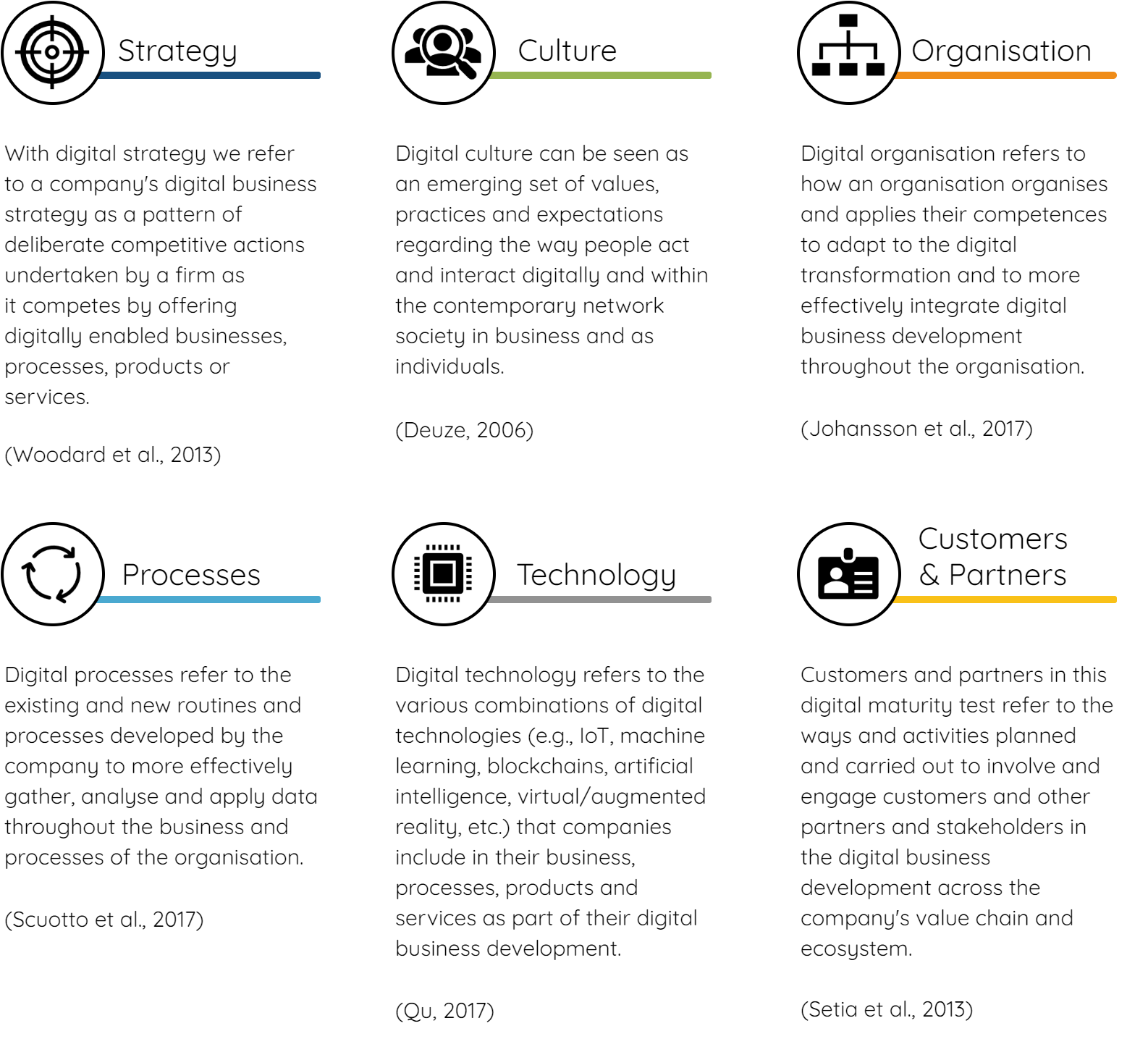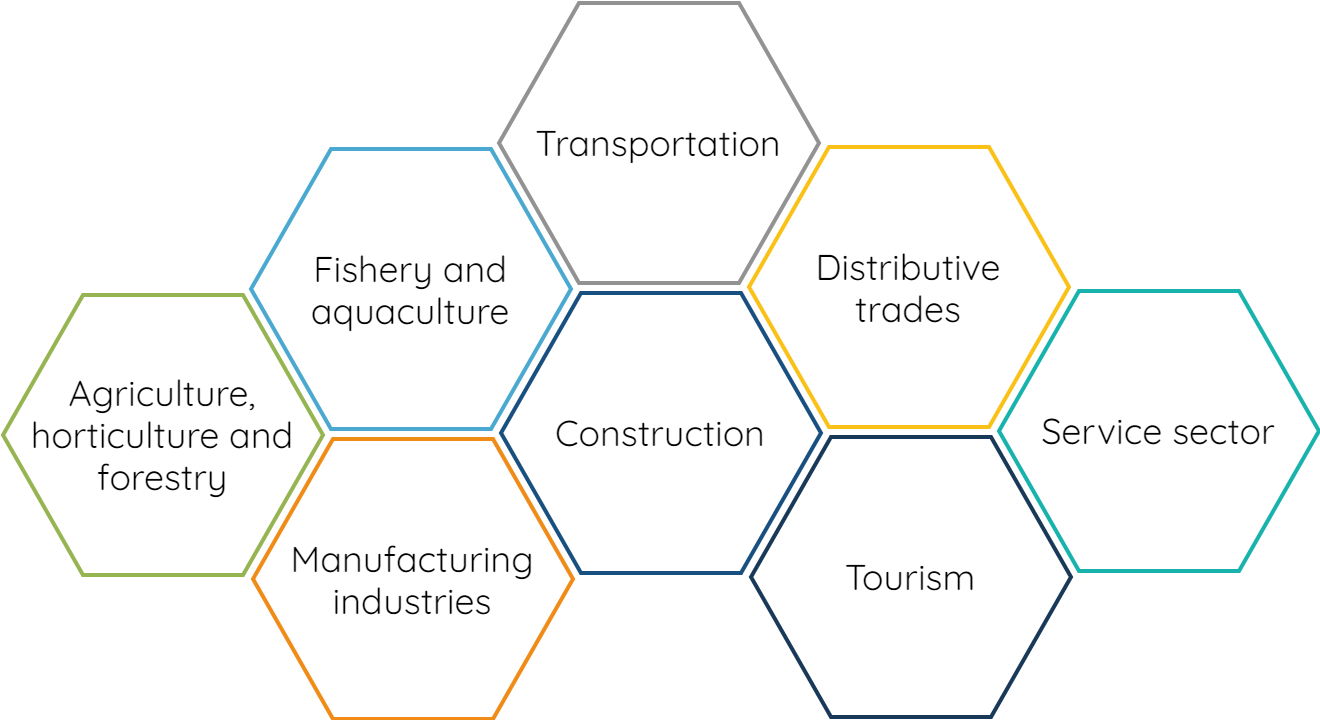What is the DMAT?
The Digital Maturity Assessment Tool (DMAT) is an online tool that, based on a questionnaire, assesses digital maturity across six dimensions: Strategy, culture, organisation, processes, technology as well as customers and partners. The DMAT allows both private companies and public organisations across different industries, company sizes and geography to map their digital maturity and key digital development areas.
The DMAT development is lead by Annabeth Aagaard, PhD, Associate Professor and Centre Director at the Interdisciplinary Centre for Digital Business Development, Aarhus University. The DMAT is copyrighted by Annabeth Aagaard.
The DMAT
- Is non-commercial
- Is research-based and developed by researchers at Aarhus University.
- Is suitable for all types and sizes of organisations across industries.
- Provides a clear visualisation of your organisation’s digital maturity.
- Provides you with inspiration presented in a mini report.
- Provides insights for the digital transformation journey.
- Provides your results benchmarked against sector average.
- Can be accessed for free with permission and access credentials. See the access guide.
Click on the button below to map your digital maturity. The assessment takes approximately 15 minutes to complete.
If you wish to access the DMAT and do not yet have an access code, please go to the access guide here.
DMAT terms of use are available here.
The six dimensions of DMAT
Below, an explanation of the six dimensions applied in the DMAT to assess digital maturity is provided.

If you are interested in further elaboration on the six DMAT dimensions, and/or insights on the research behind development of the DMAT, please find the information here.
Validation of the dimensions
Through a comparative analysis of the latest research in digital maturity and the most prevalent digital maturity assessment tools, models and frameworks applied by companies, six dimensions have been identified and theoretically validated by triangulating the data collected. The six dimensions derived are: Strategy, culture, organisation, processes, technology as well as customers and partners. Finally, the DMAT has been empirically validated through a wide range of tests across projects with different types of respondents from various industries, organization types and sizes.
Benchmark origin
The DMAT is based on the sector categories as defined by Statistics Denmark, which will translate into the organisation’s final benchmark.

In the DMAT, you indicate the sector to which your organisation belongs. The average of all previous data in the selected sector is the benchmark against which your company’s DMAT score is compared. The benchmark data for a sector are shown only when the data set is above a critical mass threshold. If the threshold for your sector is not reached, your benchmark is displayed against the sum of all previous data from all sectors. Currently, the data obtained from previous research and submissions allow most sectors to be represented in the DMAT benchmark.
If you wish to access the DMAT and do not yet have an access code, please go to the access guide here.
DMAT impact measurement
Organisations can use the DMAT as a tool to assess existing digital maturity across different dimensions, thus identifying the digital strengths and weaknesses of an organisation. With this mapping, an action plan for digital development activities can be identified and implemented.
Use the DMAT to gain an insight into the digital maturity of your organisation and be able to:
- Ensure alignment across the organisation by identifying which areas need digital transformation.
- Identify the digital competitive benefits of the organisation by benchmarking your own digital performance against other actors in the same sector.
- Measure the effect of specific digital training and activities to evaluate the actual effect of the intervention on the different areas/dimensions of the organisation with a DMAT measurement before and after the digital activity.
- Ensure a cross-organisational understanding of the organisation’s digital maturity. By inviting key stakeholders across different departments to do the DMAT assessment and thereby indicate their view on the organisation’s digital maturity, you enable an overall alignment and understanding.
The DMAT assessment experience
When you start the DMAT, you will be guided through questions about your digital maturity on the six core dimensions, which are divided into 30 subdimensions. The answers and self-assessment of these dimensions will determine the digital maturity of your organisation.
By answering the questions in the assessment tool, you will receive an overview of your organisation’s digital maturity presented in a mini report, describing how well your organisation is performing compared to the cross-sector average.
In addition, the digital maturity level, whether high or low, will be included in the mini report, which also offers inspiration on how to improve your organisation’s future performance as well as the next steps in your digital transformation. The feedback in the mini report is based on a contemporary research knowledgebase and validated best practices.

All data is handled confidentially during the collection, processing, and analysis phases. Read more about the study and the data protection here.
Click on the button below to map your digital maturity. The tool takes approximately 15 minutes to complete, and your personalised mini report will be sent immediately to your email address.
If you wish to access the DMAT and do not yet have an access code, please go to the access guide here.
Transformation action plan
Based on the results and scores provided by the DMAT, the organisation will receive inspiration for which dimension to focus on and which action to take in their digital transformation. We recommend the following to kick-start digital transformation:
- Take the DMAT test – either as a team or individually with respondents from different departments to see the difference between departments and to align key development areas.
- Review the results with the team of decision makers and identify the key dimensions to be strengthened.
- Decide what actions need to be taken to improve the digitally weak areas of the organisation, e.g. by mapping an action plan for the digital development activities, including clear objectives, division of tasks and responsibilities as well as deadlines.
- Implement the action plan and involve the relevant employees, provide training and communicate the initiatives across the organisation.
- Use the DMAT again when the action plan has been carried out to measure progression from before and after, and in determining areas where you still need to focus on continuous digital transformation.
If you wish to access the DMAT and do not yet have an access code, please go to the access guide here.
Further information

Annabeth Aagaard
Professor, PhD
at the Department of Management, Aarhus University
Contact

Anita Krogsøe Skou
Digital Business Developer
at the Department of Business Development and Technology, Aarhus University
Contact

